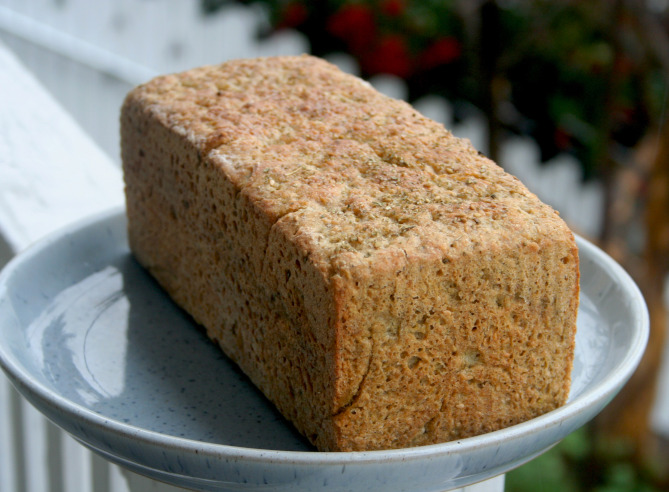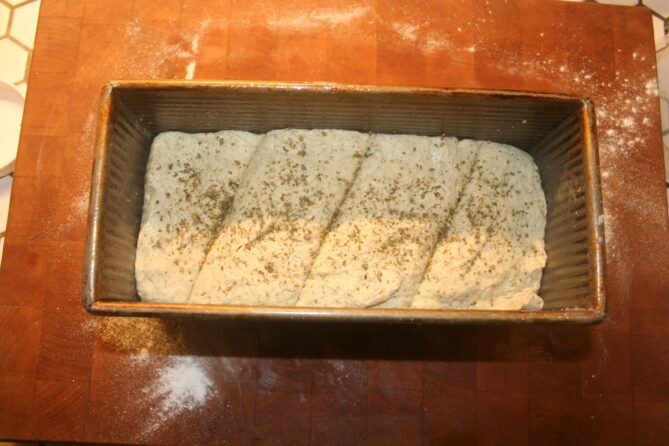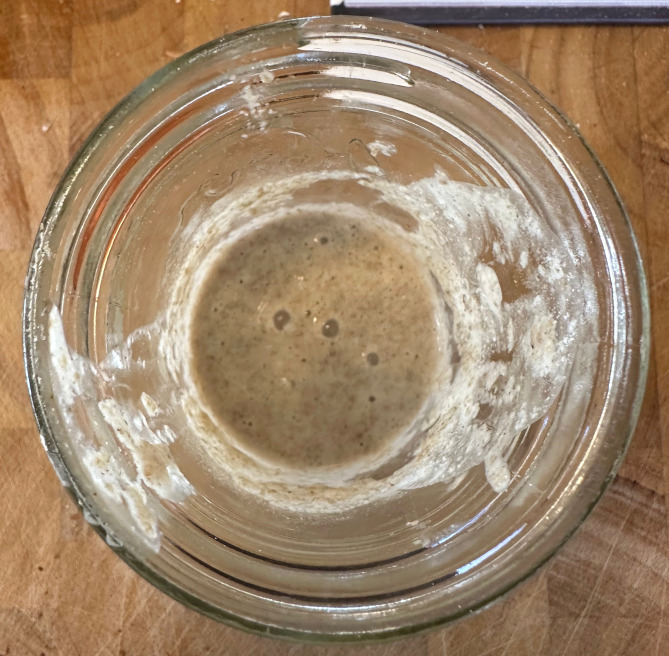This brand new video from YouTuber Internet Shaquille will resonate with anyone who owns a pizza oven and has tried to use it at a party. In short, it’s hard to operate the oven and pay attention to your guests. IS has a clever solution: bake the dough ahead of time and use it to make sandwiches. I’m definitely going to try this at our next outdoor party.
Bread
Our Daily Bread: Sonora Sesame Za’atar Bread

In an effort to take off some pandemic pudge and eat more healthy we’ve been baking our own 100% whole wheat breads. The King’s Roost and a Mock Mill make this easy and convenient but you can also get decent whole wheat flour from Central Milling and King Arthur. On my last trip to the King’s Roost I accidentally bought a bag of Sonora wheat, a white whole wheat originally brought to the Sonora desert in the 17th century. It has a light yellow color and makes a delicious bread. Sonora wheat tastes great plain but, inspired by Josey Baker’s book, I’ve been adding additional ingredients for some variety. This week I added some sesame seeds and one of my favorite spices, za’atar.
Sonora Sesame Za’atar Bread
The night before mixing your dough create a pre-ferment:
56 g Sonora wheat (or any whole wheat)
67 g water
10 g sourdough starter
In a separate container soak 90 g of toasted sesame seeds in water.
In the morning mix together:
509 g Sonora wheat (or any whole wheat)
403 g 80º F water
13 g sea salt
pre-ferment
sesame seeds
3 T za’atar
1. Mix the dough until all signs of dry flour disappear. While you’re mixing the dough heat a mason jar of water in your microwave. Place your mixed dough in the microwave to proof for a few hours. Stretch and fold the dough a few times every hour to shape into a rough loaf.

2. Once the bulk fermentation is sufficient, shape into a log and place in a greased bread pan (I use this one with Pam baking spray). Use a spatula to make some diagonal indentations and sprinkle the top of the loaf with some more za’atar.
3. Reheat your water and put the baking pan in the microwave to proof for an hour or two. When the dough is getting close to the top of the pan pre-heat your oven to 475º F.
4. Bake with the lid on for 20 minutes. Remove the lid and bake until the loaf is golden to chestnut brown, likely another 10 to 15 minutes.
Use Your Microwave as Dough Proofing Box
I don’t now why it took me so many years to realize that our kitchen temperature is too low for proofing bread. Most of the year here, except for the hotter months, our interior temps are in the 70sF (20sC). Bread wants to ferment in the 80sF (upper 20sC). Professional bakers either have a hot kitchen or proofing boxes to maintain this higher temperature.
If you’ve got a microwave you’ve got a proofing box. Just heat a mason jar filled with water for a few minutes and stick your dough in for both the bulk fermentation and proofing. If you don’t have a microwave you could heat some water on a stove and put it and your dough in a cooler. If you want to get really fancy you could use a seed propagation heating mat in a cooler. I don’t have a mat so I’ve been using the microwave and it works great.
There are reasons you might want to cool dough and prolong fermentation, either to develop flavor and/or to put off your baking time to a more convenient hour. Your proofing box and refrigerator thus become, to use an old person metaphor, like the fast forward and pause buttons on a VCR.
Concluding note
I’ve gotten back into bread baking after a pause, specifically making whole wheat breads. If you’d like to try baking yourself, at the risk of sounding like a broken record, I highly recommend the Josey Baker Bread book. Why? It’s to the point, beginner friendly, has a lot of whole grain recipes, and is the book most likely to help you develop a regular bread baking habit.
Keep a Rye Starter!

I took a pizza class at Josey Baker Bread in San Francisco this month and picked up a great tip from the instructor, JB pizza baker Caitlin (sorry did not get a last name!). She told us the bakery keeps a rye starter. This has two advantages: rye is more active so your starter will have a higher likelihood of success and you’ll always be ready to make a rye loaf. If you want a white or whole wheat dough all you have to do is add white or whole wheat flour and a spoonful of your rye starter.
I keep a small amount, like three tablespoons of starter on hand that I feed every day. When I want to make bread I do a build overnight and the next day I’ll have the quantity I need to bake a loaf or make pizza dough. This week I switched my starter over to rye using the small amount Caitlin gave us. I’m baking a loaf today and it’s rising like crazy.

As to the pizza we made in the class it was probably the best I’ve ever had. It’s a quirky pie: the secret is a dark, almost burnt crust brushed with garlic olive oil and sprinkled with Maldon salt. They keep the toppings simple as not to distract from the cracker-like sourdough crust. They have a pizza night at the bakery every Monday from 5 to 8 in case you don’t want to roll your own.
Don’t Worry About the Boule: Bake Bread in a Loaf Pan

In the frivolous, pre-pandemic before-times I slacked off on my bread baking. At the beginning of quar, I prepper-panicked, hastily re-started my starter and fired up the Mockmill 100 grain mill.
Baking with a sourdough starter puts you on a collision course with the unpredictability at the heart of the “natural” i.e. non-internet world. For me the unintended randomness of my loaves came down to the discovery that I was using too course a grind with the mill. Thereafter, my loaves improved.
Even after that simple fix, I still get can get distracted by chores and forget to shape the dough in a timely manner, thus leading to what looks more like a pancake than an Instagram worthy boule. But if you’re not making bread for the ‘gram, you don’t have to do a boule or batard unless that really floats your boat. There’s nothing wrong with baking in a loaf pan. Sometimes it’s kinda nice to have a square loaf for sandwiches anyways.
The pan I have is a Pullman pan made by USA Pan. It’s square and has a lid. The lid is especially handy in that you can do the first 20 minutes of the bake with the lid on, thus sealing in the moisture which helps with loaf spring. You don’t need the fancy Pullman type with the lid but if you’re going to buy a pan I’d suggest getting a Pullman. I use a bit of olive oil to keep the loaf from sticking. If you don’t have a Pullman pan, you can cover any loaf pan with a piece of aluminum foil for the first part of the bake.
You have my permission. Bake in a loaf pan.
